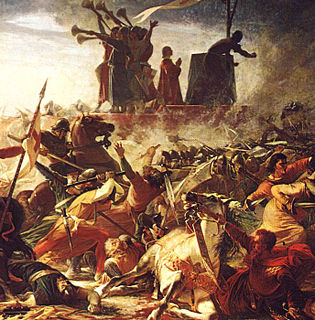 W
WDe balneis Puteolanis is a medieval didactic poem in Latin, attributed to Peter of Eboli, describing the thermal baths of Pozzuoli in the Campi Flegrei region of Campania. The poem has the alternative title De balneis terrae laboris.
 W
WThe Guelphs and Ghibellines were factions supporting the Pope and the Holy Roman Emperor, respectively, in the Italian city-states of central and northern Italy. During the 12th and 13th centuries, rivalry between these two parties formed a particularly important aspect of the internal politics of medieval Italy. The struggle for power between the Papacy and the Holy Roman Empire arose with the Investiture Controversy, which began in 1075, and ended with the Concordat of Worms in 1122. The division between the Guelphs and Ghibellines in Italy, fuelled by the imperial Great Interregnum, persisted until the 15th century.
 W
WThe Battle of Legnano was a battle between the imperial army of Frederick Barbarossa and the troops of the Lombard League on May 29, 1176, near the town of Legnano in present-day Lombardy, in Italy. Although the presence of the enemy nearby was already known to both sides, they suddenly met without having time to plan any strategy.
 W
WThe Norman conquest of southern Italy lasted from 999 to 1139, involving many battles and independent conquerors. In 1130, the territories in southern Italy united as the Kingdom of Sicily, which included the island of Sicily, the southern third of the Italian Peninsula, the archipelago of Malta, and parts of North Africa.
 W
WThe oath of Pontida, according to tradition, would have been a ceremony that would have sanctioned on 7 April 1167, in the abbey of Pontida, near Bergamo, in Italy, the birth of the Lombard League, or of a military alliance between the municipalities of Milan, Lodi, Ferrara, Piacenza and Parma aimed at the armed struggle against the Holy Roman Empire by Frederick Barbarossa.
 W
WThe Republic of Ancona was a medieval commune and maritime republic notable for its economic development and maritime trade, particularly with the Byzantine Empire and Eastern Mediterranean, although somewhat confined by Venetian supremacy on the sea. It enjoyed excellent relations with the Kingdom of Hungary, was an ally of the Republic of Ragusa, and maintained good relations with the Turks. All these relationships enabled it to serve as central Italy's gateway to the Orient.
 W
WThe Siege of Crema was a siege of the town of Crema, Lombardy by the Holy Roman Empire from 2 July 1159 to 25 January 1160. The Cremaschi tried to defend their city from the Germans, but were eventually defeated by Frederick Barbarossa's men. Frederick seized Milan in 1162 shortly after he took Crema. These events started the wars of Guelphs and Ghibellines, leading to the formation of the Lombard League, a league of northern Italian communes allied against the emperor, supported by the Pope.
 W
WAn earthquake, rated at VII on the Mercalli intensity scale, struck northern Italy and Germany on 3 January 1117. The epicentre of the first shock was near Verona, the city which suffered the most damage. The outer wall of the amphitheatre was partially felled, and the standing portion was damaged in a later earthquake of 1183. Many other churches, monasteries, and ancient monuments were destroyed or seriously damaged, eliminating much of Verona's early medieval architecture and providing space for a massive Romanesque rebuilding. After the first shock of 3 January, seismic activity persisted for months, striking on 12 January, 4 June, 1 July, 1 October, and 30 December.